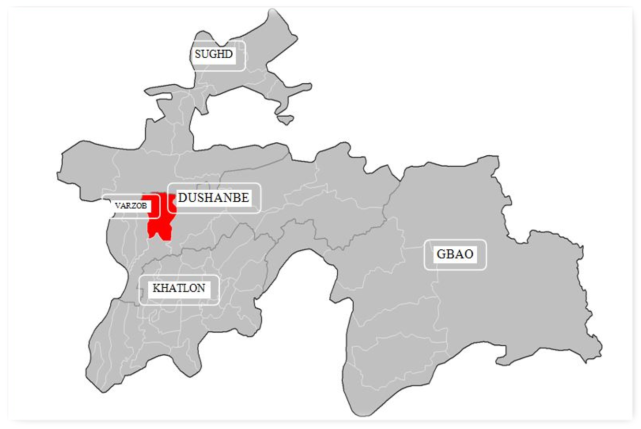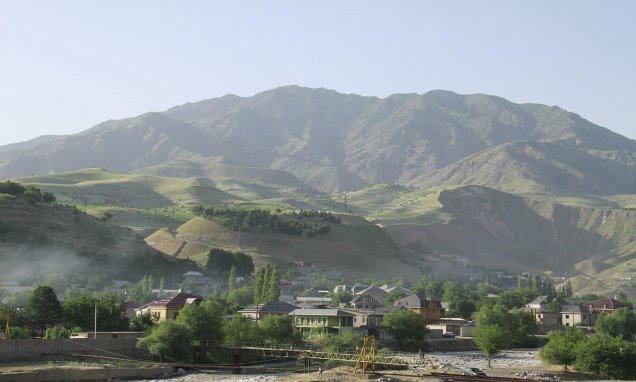This article explores the technical, social and ecological systems of drinking water, hygiene and sanitation in rural areas of the Republic of Tajikistan on the example of the Duoba village. The article describes the existing systems of inadequate sanitary standards that adversely affect the quality of drinking water, both for the population of the village and for those living downstream. The article investigates the factors of the use of outdated unsanitary systems that require updating for sanitary safety and the reasons that influence the unreasonable use of drinking water.
Keywords : Varzob region, clean water, wastewater treatment, sanitation systems, hygiene.
Varzob district is located in the Gissar valley, adjacent to the northern border of the city of Dushanbe and is one of the regions of republican subordination of Tajikistan. The borders of the district start from 10 km from the city, and the center of the Varzob district itself is located at a distance of 25 km from the capital. (Picture 1) The district was founded at the end of 1939 as part of the Stalinabad region (the current city of Dushanbe). Due to the mountainous terrain, agriculture in the region is represented mainly by animal husbandry and horticulture. In addition, various minerals are being mined. The Varzob region is crossed from north to south by the main Varzob river, which is the mouth of other small rivers in this region. The Varzob river is mainly used by the population for drinking purposes. The valley of the Varzob River near the regional center is a popular resort area, famous for its beautiful landscapes, clean air, mineral waters and sulfur springs. The Varzob valley also attracts alpinists and rock climbers, as in some places in the region the mountains reach 4 thousand meters, in some places there are glaciers. In the south of the region, on the shores of the artificial lake Varzob, conditions for comfortable rest have been created. The Varzob region includes 2 urban-type settlements and 6 rural communities with a total population of about 50 thousand in 2007 (Fig.1).

Fig. 1. Location of Varzob district (shown as red area). [Source: Picture is taken from an open Internet resource]
The surveyed rural area, the village of Duoba, with an area of 0.1168 km2 (11.68 hec.) and a population of 3600 people (UCHR 2021), is located at the foot of the hills along the Varzob River, close to the mountains. The nearby households use the river flowing along the village for household needs and as drinking water, using both gravity and pumps for water intake. The main part of the village is supplied with drinking water from the canal, which takes its course from the Varzob river mainly for the production of electricity in the cascade hydroelectric power plants Varzob HPP-1, Varzob HPP-2 and Varzob HPP-3, also partially providing the city of Dushanbe with drinking water. Unlike the city, where water is properly treated before being used for drinking purposes, in rural areas, including in our study area, there are vulnerable problems associated with access to clean drinking water and sanitation systems, which are associated with social and environmental -technical problems.

Figure 2. Illustration of Duoba village. [Source: Picture is taken from an open Internet resource]
Overview of the current situation
According to the information provided in the article «Water Systems, Hygiene and Sanitation in Rural Areas of Uzbekistan, Tajikistan, Mongolia and China: Problems and Solutions» published in the electronic portal «LIVEN» (Living Asia) where the World Bank Report is cited, according to which for 2016, only 38 percent of Tajik residents have access to safe drinking water. While 78 percent use basic services related to the availability of drinking water and only 53 percent have access to basic sanitation (Aliya Boranbayeva 2021). Up to now, in the implementation of the water sector reform, the old problems have changed significantly, but still there are significant tasks that need to be addressed.
On the example of the village of Duoba, where the study was carried out, technical, environmental and social problems were identified.
First of all, the hilly terrain and the chaotic structure of houses are a huge challenge, which makes building a centralized sewerage system almost impossible. Based on the following, as in other rural areas, simple dry toilets are used. Until some time, this was normal, since the population, having a sufficient estate, could simply bury the filled hole and dig a new one. But recently, on the one hand, due to population growth, on the other hand, the construction of country houses in any previously free land makes the population switch to more economical methods, where it is unnecessary to dig new holes every time. The solution to this problem was found by the population to concrete the pits, thereby using the transport removal of feces when filling the pit. This method is one of the effective methods, which is advised for densely populated areas without a single sewer outlet (Compendium of Sanitary Technology, 2021). This method has been effective until now, until groundwater was used. But with the growth of the population, there was a problem with the lack of both drinking and household water, as a result of which a certain percentage of the population began to switch to the use of groundwater and, taking into account the fact that the village is located along the river, then in certain groundwater levels start already from 3–4 meters underground. The situation is aggravated by the fact that in this area the soil is a mixture of loam, sand and stones, which has very high water permeability. Based on the foregoing, in toilet pits where the lower part is not concreted in order to release gray and yellow water into the ground and long-term use of the pit, the upper layers of groundwater are contaminated and are not subject to direct drinking use.
Along with sanitary and technological difficulties, there are also social challenges that must be solved in order to achieve sanitary security and have access to safe drinking water. One of the most important factors in this branch is the lack of involvement of the population, which, in particular is due to their lack of awareness of sanitation, in particular, temporary residents (summer cottages). Moreover, the lack of proper control of sanitary standards in some cases leads to the fact that some homeowners directly throw gray and yellow water into the river.
Conclusion and Recommendation
Based on the results of the study, specific tasks were identified, the solution of which was an integral part of achieving proper sanitation and clean drinking water.
First of all, it is necessary to replace inadequate septic systems in places with high groundwater levels while taking into account the type of soil. This issue can be resolved in several ways. The best option is to improve existing septic systems so that infiltration occurs much longer, thereby purifying wastewater in a natural way. It is also necessary to regularly carry out explanatory work among the population on the use of groundwater, while not forgetting about the treatment of these waters when used for drinking purposes.
The Twin Pit Dry system is also recommended, where two pits are used in alternating order. Dual Pit Systems include Dual Ventilated Improved Pit (VIP) and Alternative Pit (FA). Alternating pits allows runoff to leachate into the soil and sludge to decompose in one pit while another pit is in use. The alternating system reduces the amount of humus that needs to be removed and makes the final product more hygienic.
Twin Pit Dry systems can be designed as a double pit, double VIP or FA. In double VIP, excrement is converted to pit humus, while in FA, additional organic materials are added to the pit. After each use of the fuel assemblies, dry organic materials such as ash or leaf litter are added to the pit. The FA is built with a shallow pit, about 1.5 m deep, while the double VIP pit can be up to 3 m deep. In both systems, the two pits are used interchangeably. Waste water is filtered into the soil. When the first pit fills up, it closes and the toilet user interface switches to the second pit. While the second pit is in use, the materials in the first pit can decompose and dry, shrinking and becoming more hygienic. Due to the long dormant time, the material in the pit is partially disinfected and is similar to humus. A typical shift cycle is 6–24 months depending on the size of the pit and the number of users (Emergency WASH Knowledge Portal, S.5).
Drinking water, regardless of what resources it is used from, in turn must be carefully processed in order to meet sanitary standards. Currently, the main centralized part of drinking water, which is taken from the canal, is treated by the simplest method of sedimentation in two tanks, after which it is distributed to the houses. At first glance, it seems to be effective, but due to the fact that the population uses without any pasteurization, it will be more effective if these resources are better processed before distribution to households. There are many methods for this, such as coarse filtration, which is used to remove suspended solids from very turbid water using filter media of various sizes, from coarse gravel to fine gravel; fast sand filtration, using coarse sand as a filter medium to remove fine suspended solids from water with varying degrees of turbidity for pre-treatment before the disinfection process; microfiltration using membranes that provide excellent filtration with low final water turbidity and a high level of removal of pathogenic bacteria, after which, as a final step, it can be treated with chlorination; slow sand filtration; and many other proven methods, which are detailed in the Emergency WASH Knowledge Portal.
And in conclusion, the obligatory proper control of sanitary standards, without which all of our above-mentioned solutions will not have a sufficient effect.
References:
- Chorbog Jamoat Department of Varzob district of the Republic of Tajikistan (Dushanbe, 2021)
- Aliya Boranbayeva (2021), independent communications consultant for the electronic portal Liven.
- Emergency WASH Knowledge Portal (https://www.emergency-wash.org/)







